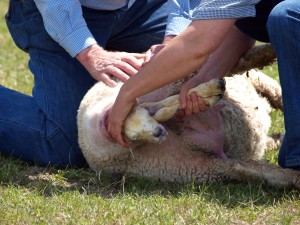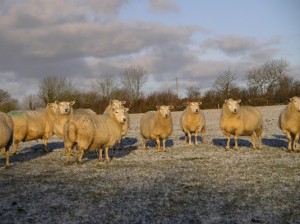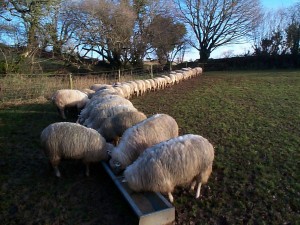The Breeding Season
In temperate countries, sheep tend to be seasonal, short day breeders although the onset and length of the breeding season can be breed-dependent . In countries where there is little fluctuation in day length, sheep generally breed year round. The pineal gland at the base of the brain produces a hormone called melatonin as soon as it gets dark and ceases this process abruptly at dawn. Only when the days get shorter is enough melatonin produced to stimulate sexual activity. However, not only the day length is important, but also whether the day length is steadily declining or increasing. Increasing day length inhibits, which makes breeding more difficult in the spring and early summer than after the longest day has passed. The length of the oestrus cycle in ewes is approximately 16 to 17 days. It is slightly shorter in younger ewes.
Ewe Nutrition and Breeding
Lambing percentage, or the number of lambs raised per 100 ewes, can be improved by several methods. A rising plane of nutrition at the time of mating (also referred to as tupping) is an
![images[5]](https://www.farmhealthonline.com/wp-content/uploads/2016/02/images5.jpg)
Breeds in the tropical areas, where the hours of day light remains constant, are able to produce lambs all year round
Ewes in poor condition at lambing time, or those that have lost a lot of condition since tupping (mating) are more likely to have problems at and after lambing, as will their lambs. Thin ewes
are more likely to have difficulty delivering their lambs through exhaustion, show impaired maternal behaviour, have less colostrum and milk and reduced fertility. Their lambs are more likely to be light and weak at birth and slow to stand and suck. This will also contribute to a weak bond between the ewe and lamb. Inadequate feeding, snow cover, chronic disease, lameness, worm infestation, flystrike, stress (isolation, handling, weaning, etc) can all contribute to loss of condition.
For more on Body Condition Scoring.
During Pregnancy
It takes about three days for the embryo to negotiate the oviduct and enter the uterus. The embryo floats freely in the uterus and ‘hatches’ from its shell when it is about a week old. It attaches itself to the inner lining of the uterus between approximately 15 and 30 days into pregnancy. During this first month the embryos are very vulnerable, and about a quarter of them perish (Henderson, 1990). It is therefore important that during this first month of pregnancy ewes are kept on an adequate level of feeding (see above). This is especially crucial on hill farms, where weather conditions are often atrocious during the mating period. Ewes should not be handled during this period, to avoid stress.
•The ewe is wandering about with a wet or bloodstained rear end, but there is no sign of a lamb. She has either aborted or has given birth to a healthy lamb which has been abandoned or stolen. Check the approximate lambing date from the ram raddle mark.
•The ewe has been straining for an hour or more, but there is no sign of a lamb appearing at the vulva.
•The ewe has been straining for some time, with part of the lamb visible at the vulva, but is making no headway.
•Part of the lamb is visible at the vulva, but the ewe has given up straining and is wandering about unconcerned or lying away on her own.
•The ewe is straining, the waterbag has burst (wet behind), but no progress has been made for some time.
•The lamb is obviously being born in an abnormal position – for example, tail first, or head first but without one or both of the forelegs.
•A ewe which has prolapsed the vagina and been stitched up, or had a retainer and truss fitted, is showing signs of being about to lamb.
•A ewe known to be carrying multiple lambs (i.e. scanned) has apparently finished lambing, but has not produced the expected number of lambs.
•A ewe has been restless and uneasy for an excessively long period, but has not yet begun to strain, or does so only intermittently. Afterbirth may be seen at the vulva, but no sign of a lamb.
At Lambing

Assistance at lambing should only be given if the ewe cannot lamb on her own and the lamb’s life is at risk
The philosophy at lambing should be one of maximum supervision with the minimum of interference. If shepherds have to assist a high proportion of ewes (more than 1 in 15-20), then they are interfering unnecessarily or there is some other fault in the management or breeding of the flock. Difficult lambers should be identified, and a decision made whether to retain such animals and their offspring for future breeding. A ewe should only be assisted at lambing if an examination reveals that she is unlikely to lamb successfully on her own or that further delay may jeopardise the life of the lambs. Ewes that have been unwell during pregnancy are best penned up in a separate area for ease of observation.
Although sheep do not tend to seek shelter for lambing under normal conditions (Stevens et al., 1981), providing shelter during inclement weather can lead to a reduction in mortality of lambs born (Alexander et al., 1979;). Lamb mortality increases significantly in wet weather in winter, and the ability of lambs to survive these conditions is greater if the birth has been short (Arnold and Morgan., 1975). It has been suggested that ewes can be trained to use shelter and that this in turn can impact positively on lamb mortality, and that the training may include strategic shearing in cooler months to encourage sheltering (Lynch et al., 1980). Ewes tend to use shelter more immediately after lambing (Pollard et al., 1999).
A series of videos have been produced by the AHDB Beef and Lamb organization providing practical advice to maximise lamb survival rates. For further information visit the AHDB Beef and Sheep TV website.
Maternal behaviour is key to ensuring survival of lambs, particularly when a ewe has two or more offspring. Newborn lambs need milk and immunological protection shortly after birth, and early interactions between the mother and the young are critical in this respect (Nowak., 1996). For more on Maternal Behaviour.
Examination and Assistance Procedures at Lambing
• Have everything you need close by before attempting a vaginal examination.
• For health and safety reasons, wearing gloves is advisable.
• Cleanliness is essential.
• Use copious lubrication to be able to manipulate the lamb without causing damage to the lamb or the ewe’s reproductive tract.
• Examination and manipulation should be carried out with the greatest care.
• If an examination reveals a normal lambing is in progress, be patient and allow the ewe to lamb on her own.
• If manipulation is required, gently return the lamb to the womb (uterus) – never attempt to do this in the birth canal.
• If you cannot correct the problem within about 5 minutes, give up and seek veterinary assistance.
• Always inject the ewe with short-acting antibiotics after manipulation, and keep the ewe nearby for frequent observation. Herbal pessaries may also be useful.
Ewes which have had a difficult lambing are less likely to nurse their lambs successfully. Always check the ewe has colostrum for her lambs (Henderson, 1997).
To ensure maximum growth of the placenta and an adequate supply of milk after lambing, it is vital to feed ewes appropriately during mid-pregnancy. Ewes with a condition score of 2.5 at mating should not be allowed to lose weight. Ewes with a condition score of 3 to 3.5 at mating are allowed to lose condition of up to half a condition score, but only if they have not lost condition during the first month after mating.
Scanning ewes mid-pregnancy to determine the number of foetuses present enables appropriate feeding during the latter stages of pregnancy. Scanning also enables more attention to be focussed on ewes bearing multiple lambs. Suitable handling systems have to be set up to reduce the amount of stress during scanning (see Sheep Housing and Handling section for more information on handling facilities).
Ensuring lambs receives sufficient colostrum is critical and insufficient intake can result in starvation, hypothermia, disease and death.
A series of videos have been produced by the AHDB Beef and Lamb organization providing practical advice to maximise lamb survival rates. For further information visit the AHDB Beef and Sheep TV website.
Dystocia
Dystocia occurs when the ewe experiences a prolonged labour and/or has difficulty delivering a lamb without assistance. Incorrect presentation of the lamb, heavy lambs in relation to ewe (especially singles), first time mothers, thin or over-fat ewes and excessive disruption during lambing may all be contributory factors. There may also be a breed factor and it may be possible to select against dystocia.


 American English
American English



Comments are closed.